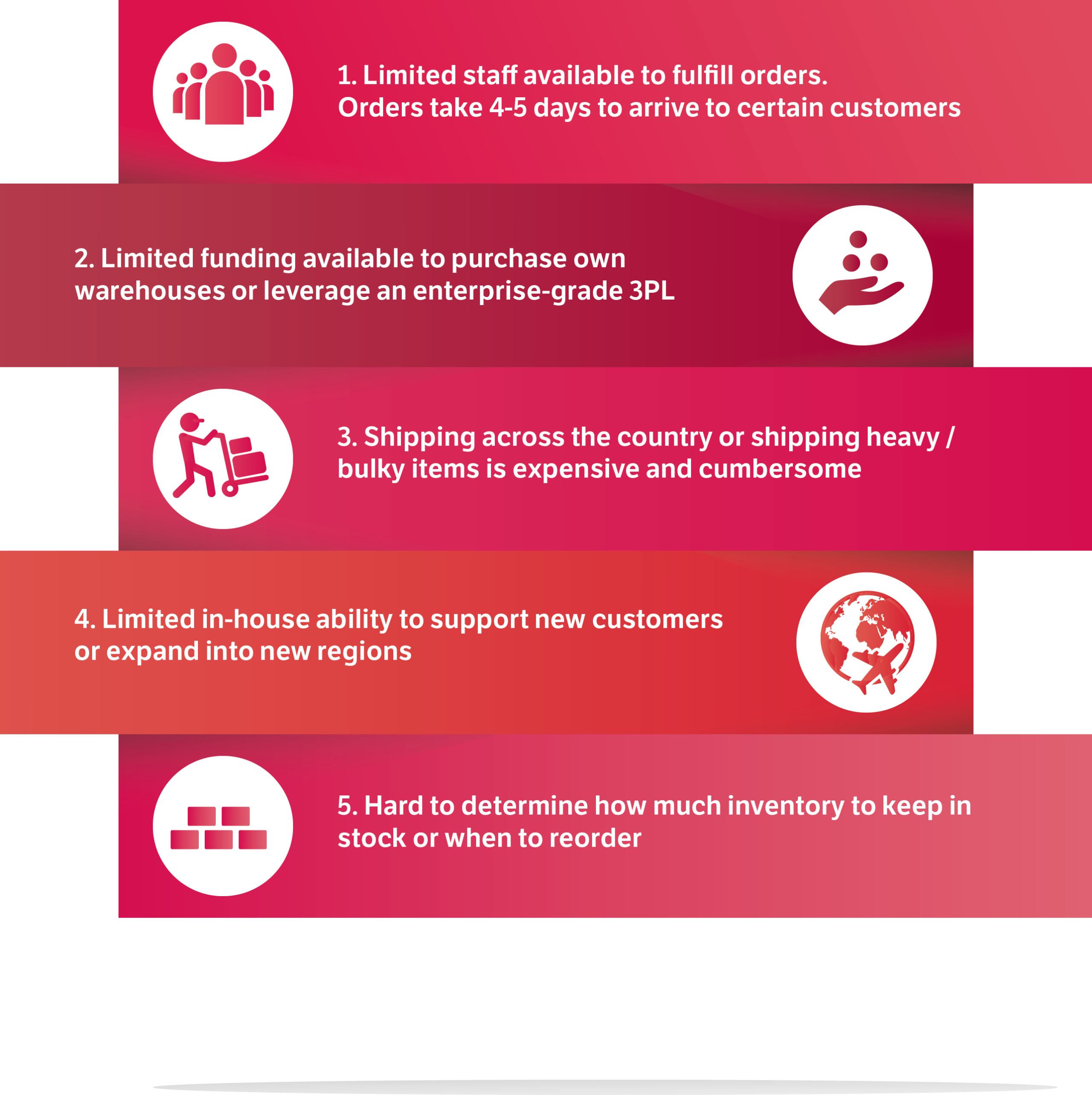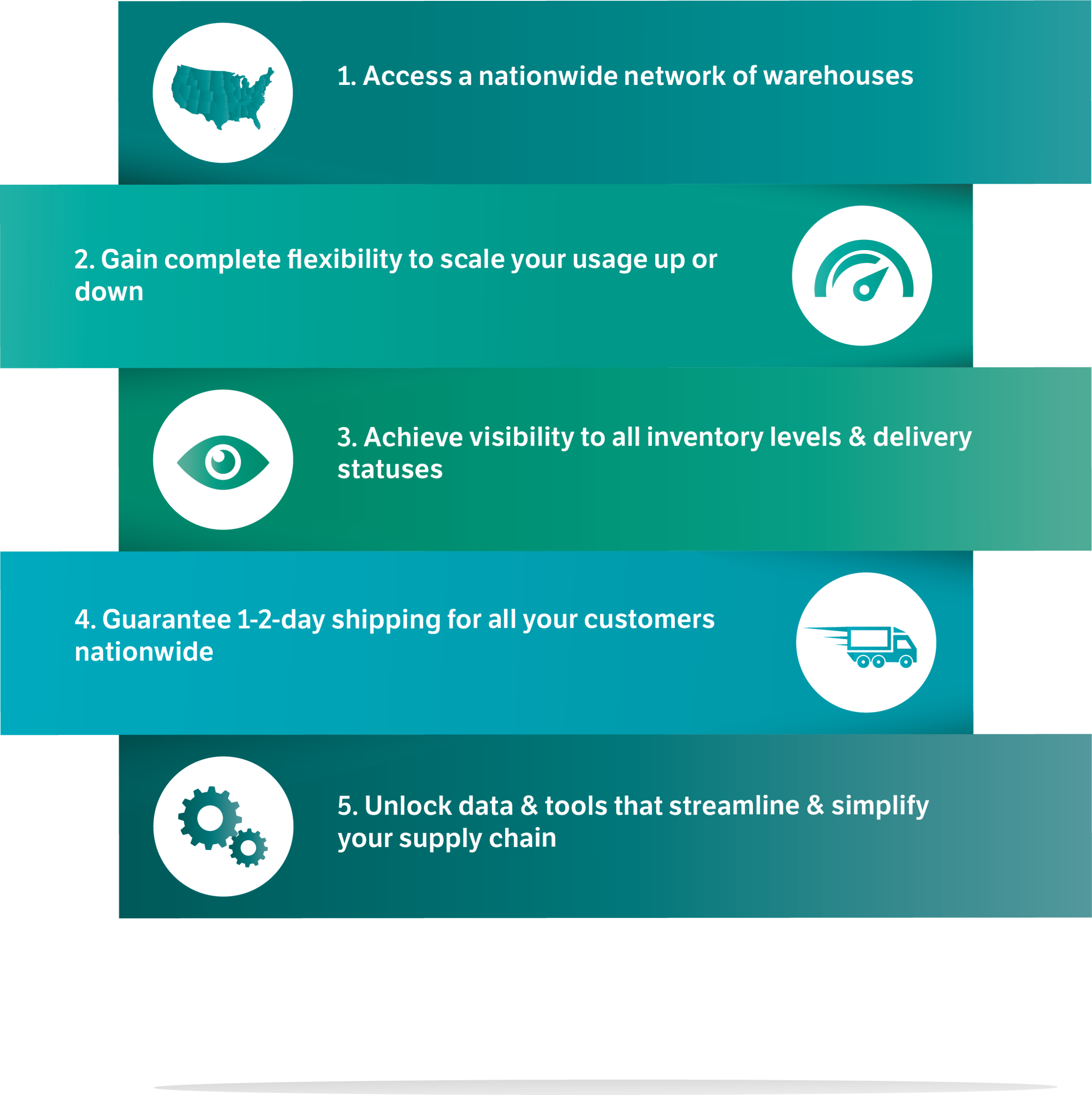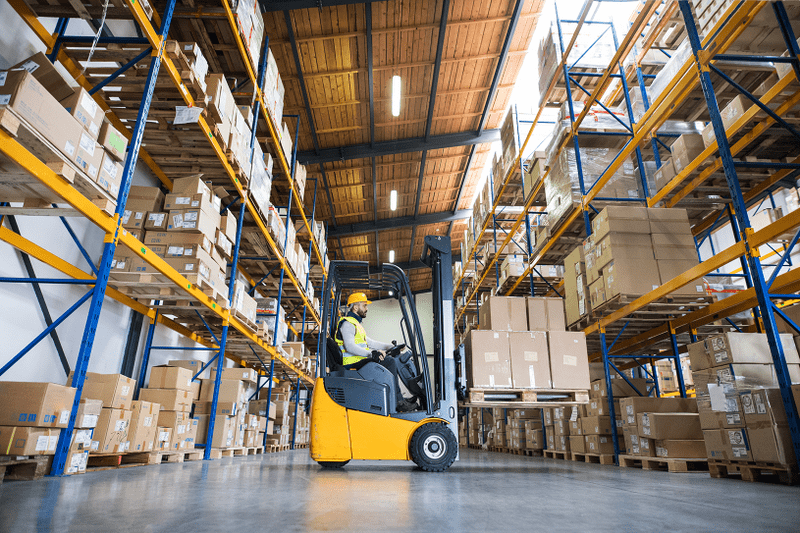How can SMBs upgrade their fulfillment workflows without depleting their budget or overwhelming their staff? Learn how businesses of all sizes can compete in today’s fast-paced ecommerce marketplace with the right warehouse partner.
Table of Contents
Knowing When Your Small Business Needs a Warehouse Partner
When Your Small Business Goes National
Warehouse Challenges for Small Businesses
Fulfillment Expectations for SMB’s
Warehouse Requirements for Small Business
Small Business Warehousing FAQ’s
Knowing When Your Small Business Needs a Warehouse Partner
As Dave Colina, CEO and founder of O2 Recovery puts it, his entrepreneur story is like many others in the CPG industry. In the early days of his brand, fulfillment was very simple. He would receive an order, stock up his car with the product, and then deliver the order to himself to O2’s retail partners.
As time went on and the business grew, it became more and more challenging to manage fulfillment in-house. O2 then moved to a regional 3PL. Then, as they began to establish a nationwide footprint, they added on additional fulfillment partners to cover their new geographic markets. Eventually, managing multiple fulfillment providers became an operational burden and more of a hindrance to growth than anything else. This was the moment that O2 knew they needed a single warehouse partner that could meet all of their needs.
After finding a warehouse partner with a national footprint and the capabilities to fulfill LTL retail shipments and small parcel D2C shipments through a single platform, O2 knew they were poised for exponential growth. In 2020 they launched their Shopify store, ramped up their D2C sales channel, and ultimately grew their business by 5x year over year.
When Your Small Business Goes National
For SMB’s managing high shipment volumes or complex (heavy or bulky) products, having to personally pick, pack, and ship every new order can quickly become overwhelming. This is especially true as the rise of ecommerce gives small businesses access to a broader base of potential customers. For businesses that sell online, the reality is that you could suddenly attract new customers on the other side of the country at a moment’s notice. But without the right fulfillment structure, you may not be able to effectively reach them.
With regards to your own business, consider a scenario where customers begin ordering products from a new location, be it Canada, California, New York, or Texas. This is great news from a sales standpoint, as it means you are being exposed to a larger base of buyers. But while the ability to leverage your online presence to increase sales is an advantage, consider what it takes to cost-effectively and efficiently deliver your products to these far-away customers without a fulfillment center for your small business.
Warehouse Challenges for Small Businesses

Fulfillment Expectations for SMB’s
In today’s competitive business environment, customer expectations for ecommerce have grown incredibly demanding. This is true both with regards to how fast they expect orders to arrive, and how much it will cost them to ship. In fact, a 2021 consumer survey revealed that 33% of shoppers have higher expectations for fast shipping as a result of the COVID-19 pandemic, and 40% have higher expectations for free shipping as a result of the pandemic.
Today’s shoppers do not expect to choose between fast shipping or cheap shipping. They want, and have come to expect, both. And in a fast-evolving market where huge companies like Amazon and Walmart are delivering next-day or even same-day shipping to customers at little cost, small businesses are under immense pressure to increase the efficiency of their own fulfillment workflows or risk falling behind.
However, achieving this level of fulfillment efficiency requires access to a nationwide distribution network that few small businesses can create themselves. And without the millions or billions of dollars in funding available to the industry’s largest players, these small businesses are struggling to compete. But given their circumstances, where should small businesses even start? How can they upgrade their fulfillment workflows without exhausting their budget, or obtain the bandwidth necessary to quickly fulfill orders without overwhelming their staff?
For a growing number of small and mid-sized businesses, the answer lies in on-demand warehousing and fulfillment.
On-demand warehousing and fulfillment is simply a service that provides businesses with a network of warehouses and fulfillment centers across the country that they can use as-needed to position and distribute their inventory closer to customers. The on-demand provider manages the network of warehouses and helps businesses strategically select and then inbound their inventory to the most appropriate locations. Then, as new customer orders are acquired, the on-demand provider will manage all pick, pack, and delivery workflows on the client’s behalf.
Warehouse Requirements for Small Business

Small Business Warehousing FAQ’s
How much does it cost to run a warehouse? The cost of running a warehouse is highly variable based on product and storage needs, the size of the warehouse, and the level of automation. The costs that any small business owner should consider when thinking about running a warehouse include, equipment maintenance, labor, insurance, and a dedicated WMS.
Is warehousing profitable? Most small to mid-sized businesses find that the cost of running a warehouse depletes their margins and takes their staff’s attention away from their core competencies. Even larger merchants like children’s furniture retailer, ECR4Kids, often find that their resources are better spent on product development and customer service and rely on an outsourced fulfillment partner.
What is warehouse as a service? Warehouse as a service (or WaaS) is a model of fulfillment that is highly flexible and scalable to meet the needs of today’s ecommerce merchants. WaaS are typically on-demand, technology-focused, and offer multichannel fulfillment solutions.
Do I need a warehouse license if I have a small warehouse? The need for a warehouse license varies depending on your location and the nature of your business. It’s essential to check with local authorities and regulatory bodies to determine specific licensing requirements for operating a small warehouse. Some areas may have zoning regulations or business licensing requirements that you need to comply with.
How should I set up my warehouse? Setting up a warehouse involves several key steps. First, identify your storage needs, including the type of products you’ll be handling. Then, secure a suitable location with consideration for size, accessibility, and safety. Acquire necessary equipment such as shelving, pallet racks, and a Warehouse Management System (WMS). Implement efficient inventory management practices and establish workflows for receiving, storing, and fulfilling orders. Finally, ensure compliance with local regulations and safety standards.
How do warehouses make money? Warehouses can generate revenue through various means. One common model is offering storage services where businesses pay for the space they use to store their products. Additionally, warehouses may provide fulfillment services, handling the picking, packing, and shipping of orders for ecommerce businesses. Some warehouses also offer specialized services such as temperature-controlled storage, which can command higher fees. The adoption of technology, like automation and data analytics, can enhance efficiency and contribute to the profitability of warehouse operations.
Looking for a warehouse solution for your small business? Reach out to one of our fulfillment experts today.




